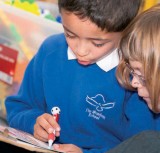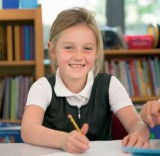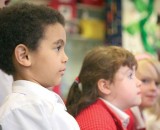It's best if children devote their time to discovering different ways of displaying and interpreting data, says Mike Askew...
It used to be case that a lot of classroom time on data handling was spent with children making block and bar graphs. In reality, most graphs are now produced electronically. So, while making the occasional graph is helpful, it is more valuable for children to explore lots of ways of organising and displaying data and answering questions about it. And what better way for children to experience this than by organising themselves?
 As a prelude to work on bar charts and pictograms, children can be invited to make human bar charts, but first they can work on the idea of sorting themselves into small groups.
As a prelude to work on bar charts and pictograms, children can be invited to make human bar charts, but first they can work on the idea of sorting themselves into small groups.
Put the class into groups of about eight and ask each group to stand in a line facing the front of the class. Ask:
How quickly can you find the tallest person in your group?
Children will soon sort themselves out into a line with the smallest person at one end and the tallest at the other and in so doing will be engaged in a lot of comparing of heights.
Now ask them to sort themselves by house number, or the day of the month their birthday is on.
Challenges like sorting by shoe size or numbers of brothers or sisters are likely to mean that a single line is not suitable, and two or three children may have to stand behind each other. Children can then take a different coloured cube each and use these represent their orderings. This will start with putting the cubes out in one line, and progress to piling some cubes up on top of others eg (e.g. three children have no brothers or sisters), thus producing instant mini-block graphs.
Bring the children together as a class and invite them to go and stand in new groups, this time in response to questions with ‘yes/no’ answers:
• Do you like Marmite crisps?
• Do you walk to school?
• Do your shoes have laces?
An extension to this is to get the children to line up facing you.
 You decide on a ‘secret’ rule (wearing a sweater). Each child approaches and is directed to the left or right according to whether or not they fit your rule. Once the two groups have been established, can the children figure out what your rule was? Children can take it in turns to think of a rule and sort everyone out.
You decide on a ‘secret’ rule (wearing a sweater). Each child approaches and is directed to the left or right according to whether or not they fit your rule. Once the two groups have been established, can the children figure out what your rule was? Children can take it in turns to think of a rule and sort everyone out.
An ‘instant graph’ chart can easily be set up and used most days to do some data handling (and a bit of calculating). All that is needed is a board about one metre by fifty centimetres (strong cardboard from a package will do) with a line drawn down the centre, lengthwise. A collection of spring clothes pegs, paper and a bulldog clip, complete the set up.
Each morning, before the children arrive, clip paper to the top of the board with a ‘yes/no’ question on it (Do you like cabbage?). Label the halves of the board ‘yes’ and ‘no’. Children collect a peg and clip it to the side of the board according to their answer to the question. An instant, visible representation of the data is created and you can discuss this as well as looking at the numbers on each side and the differences between these.
In lower Key Stage 2 children begin to work on data that is presented in tables and to construct frequency tables, which includes discrete data that is grouped. This allows them to look at the range and mode of the data. What’s your score? provides a way of quickly collecting data that allows these ideas to be introduced and explored.
 Demonstrate to the class how to make a star by drawing a triangle and then drawing a second inverted over the first. Let the children practise drawing these. Explain they are going to have one minute to draw as many stars as they can. Emphasise that the point here is not to try and ‘win’ by drawing the greatest number of stars. They should draw the stars as quickly as they can but not sacrifice making them reasonably accurate for speed.
Demonstrate to the class how to make a star by drawing a triangle and then drawing a second inverted over the first. Let the children practise drawing these. Explain they are going to have one minute to draw as many stars as they can. Emphasise that the point here is not to try and ‘win’ by drawing the greatest number of stars. They should draw the stars as quickly as they can but not sacrifice making them reasonably accurate for speed.
After the children have had a practice, time them for exactly one minute. They count up the number of stars they complete.
Provide the children with 1 − 100 number lines (with every number marked) and also put a number line on the board to complete as the children are completing their own.
Go round the class asking each child to call out their score. For each value an X is marked above that point on the number line. If a score is called out again a second X is marked above the X already there - a sort of block graph is built up.
Talk about the highest and lowest scores and get the children to figure out the difference between these two values. When the class has agreed on this value, discuss how this value is called the ‘range’ of the data.
Which scores have more than one X on them? Is there a score that has more Xs than any other score? That is the ‘mode’ value of the data.
All being well, the Xs will be spread out along the number line with most values only having one or two Xs on them, if any. Discuss with the children how the Xs from a sort of ‘instant’ graph, but that is it a bit ‘spreadout’ and rather ‘flat’. Discuss how, rather than recording the exact score of every child, the scores can be put into groups of, say, scores between 20 and 24. Work with the class on agreeing on a set of groups that will reduce the data to around six or so sets. This will depend on the range of the scores. For example, if the scores have a range of around 50 (from say 25 to 76) then the groupings might be 20- 29, 30-39, 40-49, 50-59, 60-69, 70-79. But if the range is smaller, say around 20 (from 22 to 41) then the groups need to be smaller, 20-24, 25-29, 30-34, 35-39, 40- 45.
Draw up a table for the groupings chosen and get the children to each create their own.
Go round the class again with children calling out their scores once more. Now as scores are called out, everyone puts a tally into their chart to record which group the score belongs to. The children can now create block graphs of the grouped data.
Display the number line record and grouped data together and discuss why the same data looks different on each. What are the advantages and disadvantages of each representation?
As children get older they can begin to interpret a wider range of graphs and diagrams, and draw conclusions from statistics and graphs from looking at simple correlations - whether one set of data is linked to a second set. Three times round your head provides a practical way to do this.
Before going on to the full investigation, children can explore the idea of mean average from measuring their ‘crowns’.
Provide each child with a strip of paper that is more than long enough to fit around their heads across the forehead (as if making a paper crown). Working in pairs the children fold off the strip to create a reasonably accurate measure of their crown’ (but not allowing for any overlap - the ends of the strip should just meet). They cut or tear off and discard the extra paper. Everyone measures and records the length of their ‘crowns’ - some may measure this in cm and mm, some you may direct to measure it to the nearest cm.
 Working in groups of four or five with the paper strips, can the children figure out what the average ‘crown’ is for their group without using a calculator? Discuss the idea of ‘average’ being what the measurement would be if everyone had the same crown but the total of all the crowns together did not change. Children will soon realise they can tape all their crowns together, end to end, and then fold the long strip into four or five equal parts. They measure the length of this ‘average’ they have created. Using calculators and the lengths that they previously recorded, can they check by calculating if their practical way of finding the average has worked?
Working in groups of four or five with the paper strips, can the children figure out what the average ‘crown’ is for their group without using a calculator? Discuss the idea of ‘average’ being what the measurement would be if everyone had the same crown but the total of all the crowns together did not change. Children will soon realise they can tape all their crowns together, end to end, and then fold the long strip into four or five equal parts. They measure the length of this ‘average’ they have created. Using calculators and the lengths that they previously recorded, can they check by calculating if their practical way of finding the average has worked?
Each group’s combined strips can be joined to make one long class strip and the average of that found - are the children going to work practically or use the measures that people have written down? If they calculate the class average, this can then be marked off along the ‘mega’ strip to check.
The children are now set up for the challenge:
Is three times round your head about the same as your height?
Discuss this statement. What would count as ‘about’?
Provide the children with paper strips, tape measures, calculators and, if they are familiar with them, the opportunity to use spreadsheets. But apart from that, leave it to them to decide what data they are going to collect and how they will present it.
Groups have to prepare a presentation that they will give to the class on their conclusions about whether or not the claim is accurate.
Mike Askew is Professor of Primary Education at Monash University, Melbourne. Until recently, he was Professor of Mathematics Education at King’s College, University.
Make every lesson an experiment
Cross Curricular
Why Boarding School Fiction Feels Comfortably Familiar
Ace-Classroom-Support
How to be a singing school
Ace-Music
